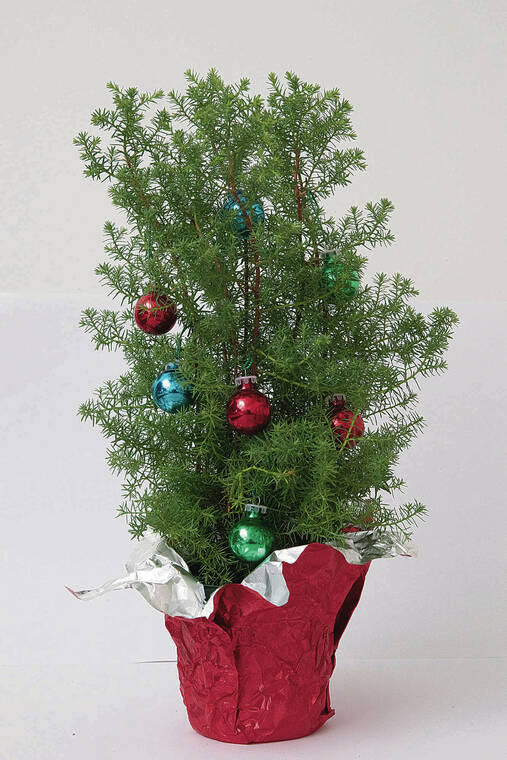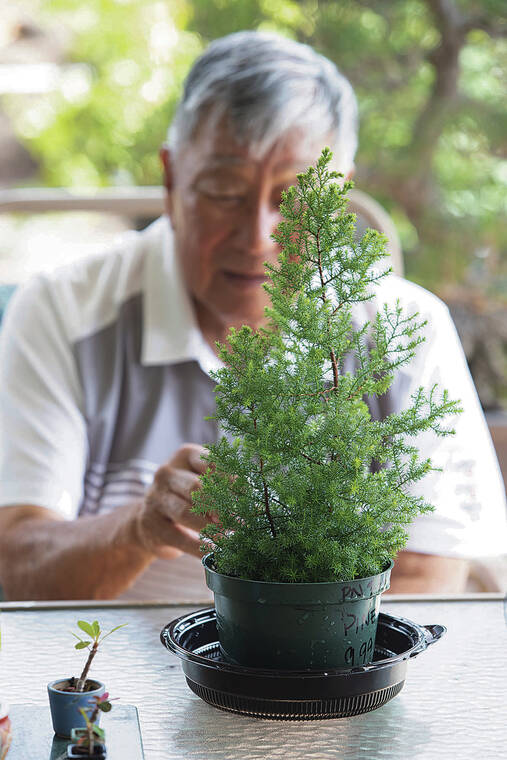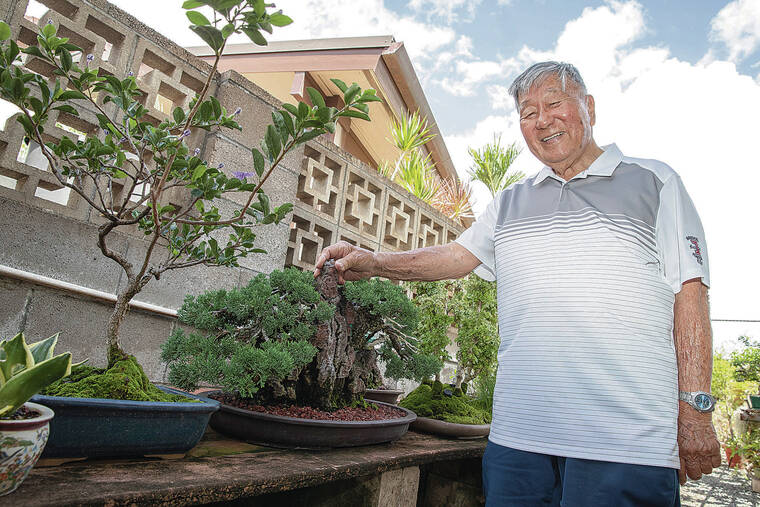How to keep the holiday evergreens alive year-round

GEORGE F. LEE / GLEE@STARADVERTISER.COM
According to Roy Yamashiroya, the key to keeping a miniature potted Christmas evergreen alive past the holidays is to water it at least once a day if kept outdoors or at least three times a week if kept indoors, preferably next to a sunny window.

CINDY ELLEN RUSSELL / CRUSSELL@STARADVERTISER.COM
Roy Yamashiroya is pictured with a Nishi juniper, which is a popular holiday ornamental.

CINDY ELLEN RUSSELL / CRUSSELL@STARADVERTISER.COM
Roy Yamashiroya, pictured with one of the rock-style bonsai plantings in his Moanalua yard, cultivates bonsai trees and is an expert on growing evergreens.



Those mini potted evergreens available at supermarkets everywhere each Christmas are tempting to grab, as they’re already trimmed in festive ornaments. But once the holidays are over, how easy are they to maintain?
Most will likely end up looking like Charlie Brown’s scraggly Christmas tree and get tossed in the trash, though avid gardeners who love nurturing plants from every and any root ball will give it their best shot.
If so, they might want to follow the advice of Roy Yamashiroya, who has over 30 years of experience growing evergreens from seeds and cuttings as a bonsai master. He is a certified sensei of the Hawaii Bonsai Association who co-founded the Classic Bonsai Club in 2000 and the Hawaii Kenkyu Kai (a bonsai study group) about 10 years ago.
Yamashiroya is also an emeritus volunteer with the University of Hawaii’s Master Gardener Program, which provides the public with horticultural advice under UH’s Cooperative Extension Service.
He said the Nishi juniper and Italian stone pine, which are the common varieties sold at Christmas, are temperamental conifers but can survive in Hawaii if they get enough water under the right conditions.
Bonsai growers don’t usually choose these fussy evergreens to work with because they can’t withstand the drastic process of having their branches bent and shaped with wire and being constantly pruned to achieve a certain form.
Don't miss out on what's happening!
Stay in touch with breaking news, as it happens, conveniently in your email inbox. It's FREE!
“If you let them go natural, they can survive a long time,” Yamashiroya said.
The key is to water them at least once a day if kept outdoors. If the plant is indoors, preferably next to a sunny window, water at least three times a week.
He recommended keeping the trees in their original container, usually a 6-inch pot, and taking the foil wrapping off. A good way to tell if a plant needs more water is to place it in a saucer or shallow pan: after watering, allow the drainage to stay in the pan, and when the saucer is dry, add more water.
It’s contrary to the axiom of not allowing a plant to sit in water, but Yamashiroya has found that evergreen roots will not get soggy with his method. Horticulturists may be doubtful, “but this is the way I do it,” he said. If people prefer, they can put a wooden chopstick into the soil and pull it out to check the moisture level.
“The most important thing is irrigation. Too much is not good or you’ll get root rot,” he said. This occurs when the holes in the pot become congested from overgrown roots, or if the soil mixture doesn’t permit effective drainage.
To avoid this, transplant the trees to a larger pot after a year or two. He suggested a container wide enough to prevent the tree from toppling over in the wind, and shallow enough to give the roots space to spread out.
Yamashiroya recommends mixing Miracle Gro potting soil for containers, with 50% black cinder for good drainage. He uses a transplanting solution called QuickStart by Miracle Grow to promote faster root growth, prevent shock and protect from disease and virus.
(He goes through an extra step of sifting the cinder to separate the larger pieces, which he puts on the very bottom inch of the pot, and uses the medium-grade pieces to mix into the potting soil; he doesn’t incorporate the finest pieces.)
The pot should be kept in a cool, semi-shady spot, perhaps on an outside patio sheltered from wind for the first month. Wind is damaging to the formation of new delicate roots if the plant sways too much in the gusts.
Acclimate the plant by keeping it in a semi-shady location for one or two months until it can tolerate five to six hours in full sun a day, he said. Once it is acclimated, the plant should be watered twice a day, and in the height of summer, he waters as much as three or four times a day when he sees the plant wilting from the heat.
For the first month after transplanting, Yamashiroya has developed his own method of growing the roots faster by soaking the plant in a pan of water for two days, deep enough to cover the roots, about half way up the container. He noted that he also cuts the root ball back when he transplants, as do most bonsai growers. He takes the container out of the water and lets it drain for a day, but still waters the plant.
Yamashiroya always uses this soaking method whenever he transplants most species, except for orchids, succulents and other plants that don’t need much water. Again, others may be afraid to allow the roots soak in water, but Yamashiroya says it’s what has worked for him over the years.
After about a month, the plant has developed air or feeder roots. Once the plant is established, watering can be cut back to once a day outside, or two or three times a week indoors. He doesn’t fertilize until a few weeks after transplanting to avoid killing the delicate feeder roots. Bonsai growers use a low NPK formula, such as NPK 9-9-9 or 8-2-2, to keep the plant from getting too large, but for most gardeners who don’t care about limiting its size, a 16-16-16 is fine. Just be sure to follow the instructions on the amount of fertilizer to use, he said.
To combat the mites and aphids that pester evergreens most, he recommends a fungicide-pesticide-miticide combination. He uses neem oil, which combines these ingredients, but makes sure to mix the correct amount in a spray bottle for it to work, and doesn’t apply it when the sun is out.
Sturdier evergreens that grow well in Hawaii include the Norfolk pine, or the similar Cook pine and the Italian cypress. He recommends keeping the Norfolk and Cook pines in a pot so they can be reused and decorated every year for Christmas, or they will grow extremely tall in the ground. Other hardy plants include the blue vase (aka blue juniper), the Monterey juniper, the nana juniper procumben, prostrate juniper and black pine.
Is there a gardening topic you’d like to read about in the Garden Variety column? Email Pat Gee at pgee@staradvertiser.com with your request.



